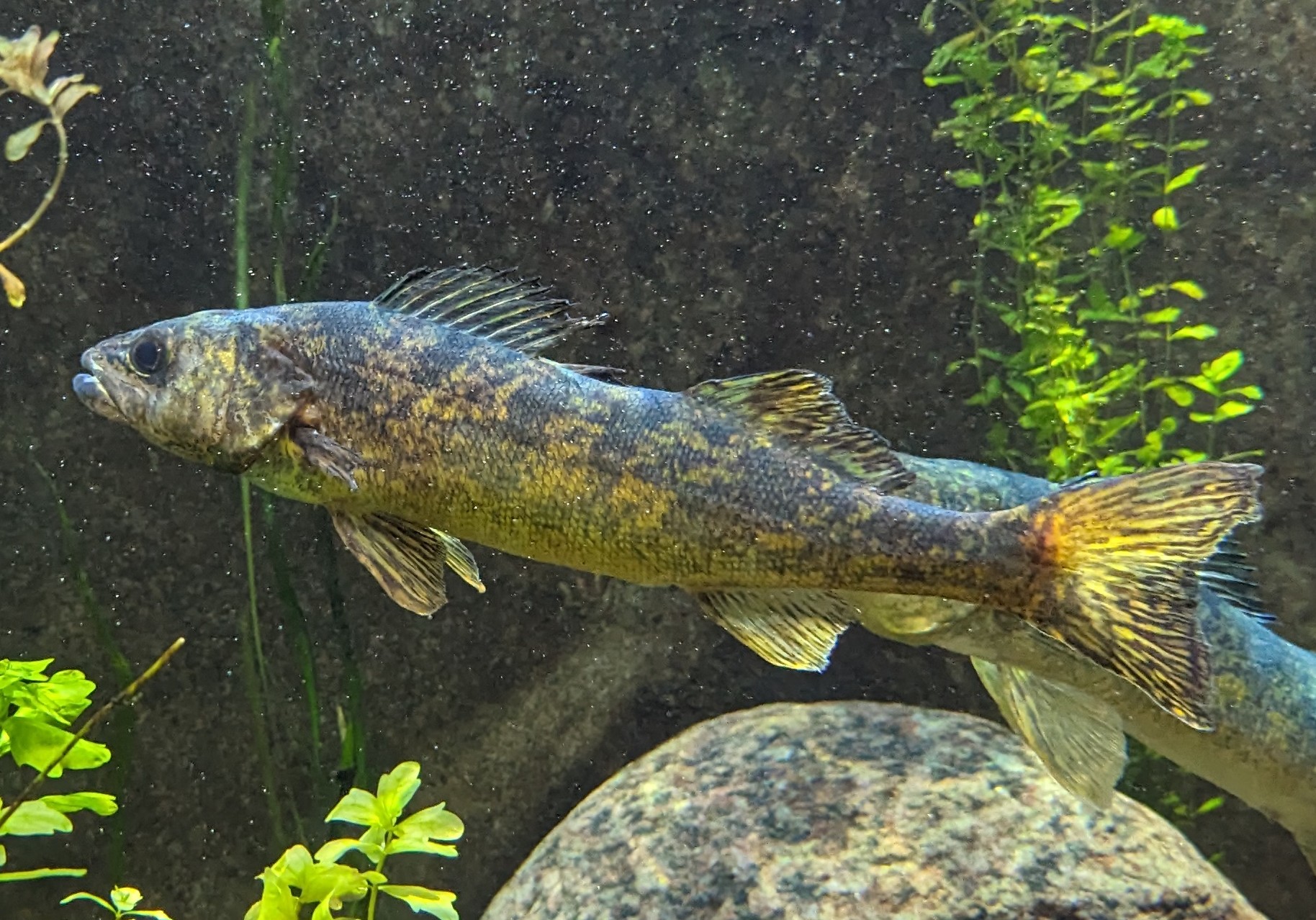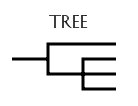Percomorpharia and Eupercaria are synonymous. NCBI uses Eupercaria but we will stick with Percomorpharia.
Percomorpharia is a major subdivision of Percomorphaceae. This page shows Percomorpharia's splits and focuses on the orders isolated by those splits. In this case, there is just one six-way split, comprised of five orders and the group Smegmamorpha. Smegmamorpha will be explored on the following page.
- Percomorphaceae
- Anabantaria (34-IX)
- Batrachoidaria (34-IX)
- Carangaria (34-IX)
- Gobiaria (34-IX)
- Ophidiaria (34-IX)
- Pelagiaria (34-IX)
- Syngnathiaria (34-IX)
- Percomorpharia (Eupercaria)
- Acropomatiformes
- Centrarchiformes
- Lophiiformes - Anglerfishes
- Tetraodontiformes
- iNaturalist Acanthuriformes
- Acanthuriformes
- Caproiformes
- Chaetodontiformes
- Ephippiformes
- Gerreiformes
- Lobotiformes
- Lutjaniformes
- Pempheriformes
- Priacanthiformes
- Spariformes
- Eupercaria incertae sedis
- iNaturalist Perciformes
- Perciformes
- Labriformes
- Uranoscopiformes
- Ovalentaria (34-XI)
The order of Oceanic Basses. As of 2024, 4 species of Acropomatiformes have been observed in iNaturalist in the US and 77 throughout the world. There are 17 families in the order.
- FAMILY POLYPRIONIDAE
- Giant Sea Bass (Stereolepis gigas) - most iNat observations in the US for Acropomatiformes. Critically endangered. - 7 (Southern California, marine, to Monterey Bay)
- FAMILY PEMPHERIDAE
- Glassy Sweeper (Pempheris schomburgkii) - 2 (Florida Keys)
The order of Freshwater Sunfishes, Grunters and allies. As of 2024, 103 species of Centrarchiformes have been observed in iNaturalist in the US and 276 throughout the world.
- SUPERFAMILY CENTRARCHOIDEI
- FAMILY CENTRARCHIDAE
- Bluegill (Lepomis macrochirus) - most iNat observations in the US for Centrarchiformes - Perry Lake, KS
- Green Sunfish (Lepomis cyanellus) - 6 (SCZ)
- Black Crappie (Pomoxis nigromaculatus) - 6 (SCZ), 8 (Shedd)
- Largemouth Bass (Micropterus salmoides)
- Smallmouth Bass (Micropterus dolomieu)
- FAMILY ELASSOMATIDAE
- Banded Dwarf Sunfish (Elassoma zonatum) - 8 (Shedd)
- SUPERFAMILY CIRRHITIOIDEI
- FAMILY KUHLIIDAE
- Barred Flagtail (Kuhlia mugil) - 6 (Omaha Zoo)
- SUPERFAMILY PERCALATOIDEI
- FAMILY KYPHOSIDAE
- Moonlighter (Tilodon sexfasciatum) - 8 (Shedd)
- SUPERFAMILY PERCICHTHYOIDEI
- SUPERFAMILY TERAPONTOIDEI
- FAMILY GIRELLIDAE
- Opaleye (Girella nigricans) - 7 (Southern California, marine)
The order of Anglerfishes. As of 2024, 19 species of Lophiiformes have been observed in iNaturalist in the US and 89 throughout the world.
- SUBORDER ANTENNARIOIDEI
- FAMILY ANTENNARIIDAE
- Giant Frogfish (Antennarius commerson) - most iNat observations in the US for Lophiiformes
- Frogfish (Antennarius sp.) - NOAH - 6 (Omaha Zoo), 2 (Florida Keys)
- Warty Frogfish (Antennarius maculatus) - 8 (Shedd)
- FAMILY BRACHIONICHTHYIDAE
- Red Handfish (Thymichthys politus) - YOUTUBE - Tasmania
- FAMILY TETRABRACHIIDAE
- SUBORDER CERATIOIDEI - 11 Families
- FAMILY MELANOCETIDAE
- Anglerfishes (Melanocetus spp.) - Monterey Bay
- SUBORDER CHAUNACOIDEI
- FAMILY CHAUNACIDAE - SEA TOADS
- Furry Coffinfish (Chaunax endeavouri)
- SUBORDER LOPHIOIDEI
- FAMILY LOPHIIDAE - GOOSEFISHES
- Monkfish (Lophius piscatorius)
- SUBORDER OGCOCEPHALIOIDEI
- FAMILY OGCOCEPHALIDAE - BATFISHES
- Longnose Batfish (Ogcocephalus nasutus) - Florida Keys, Florida Aquarium
The order of Puffers and Filefishes. As of 2024, 66 species of Tetraodontiformes have been observed in iNaturalist in the US and 325 throughout the world.
- SUPERFAMILY BALISTOIDEA
- FAMILY BALISTIDAE - TRIGGERFISHES
- Wedgetail Triggerfish (Rhinecanthus rectangulus) - 12 (Hawaii)
- FAMILY MONACANTHIDAE
- Tassled Filefish (Chaetodermis penicilligerus) - 8 (Shedd)
- SUBORDER MOLOIDEI
- FAMILY MOLIDAE - MOLAS
- Common Mola (Mola mola) - US West Coast and Northern East Coast
- SUPERFAMILY OSTRACIOIDEA
- FAMILY ARACANIDAE
- Red Boxfish (Anoplocapros lenticularis) - 8 (Shedd)
- Shaw's Cowfish (Aracana aurita) - 8 (Shedd)
- Ornate Cowfish (Aracana ornata) - 6 (Omaha Zoo)
- FAMILY OSTRACIIDAE - BOXFISHES
- Smooth Trunkfish (Lactophrys triqueter) - 6 (KC Zoo)
- Longhorn Cowfish (Lactoria cornuta) - 6 (Omaha Zoo)
- SUBORDER TETRAODONTOIDEI
- FAMILY DIODONTIDAE - PORCUPINEFISHES
- Striped Burrfish (Chilomycterus schoepfii) - most iNat observations in the US for Tetraodontiformes - US East and Gulf Coasts
- SUPERFAMILY TETRAODONTOIDEA
- FAMILY TETRAODONTIDAE - PUFFERS
- Hawaiian Spotted Toby (Canthigaster jactator) - 12 (Hawaii)
- Northern Puffer (Sphoeroides maculatus) - 10 (Coast)
- SUPERFAMILY TRIACANTHODOIDEI
- FAMILY TRIACANTHODIDAE - SPIKEFISHES
- SUPERFAMILY TRIACANTHOIDEA
- FAMILY TRIACANTHIDAE - TRIPLESPINES
- SUBORDER TRIODONTOIDEI
Acanthuriformes is an order in transition. As of 2024, it still exists in the NCBI database but it has had many of its former families split off into ther own orders. While iNaturalist has kept the order fairly intact, NCBI has adopted the scheme that has resulted in nine new orders and places some of the common families into the incertae sedis status. Those new orders and Eupercaria incertae sedis follow below. This is a good example of why it was important to find one classification system and to stick with it.
As of 2024, 30 species of Acanthuriformes (as defined by the three families still in that order in the NCBI database) have been observed in iNaturalist in the US and 83 throughout the world.
- FAMILY ACANTHURIDAE - SURGEONFISHES
- Convict Surgeonfish (Acanthurus triostegus) - most iNat observations in the US for Acanthuriformes - 12 (Hawaii)
- Clown Surgeon (Acanthurus lineatus) - 6 (Omaha Zoo)
- Yellow Tang (Zebrasoma flavescens) - 12 (Hawaii)
- FAMILY LUVARIDAE
- FAMILY ZANCLIDAE
The order of Boarfishes contains a single family. As of 2024, 0 species of Caproiformes have been observed in iNaturalist in the US and 1 throughout the world.
- FAMILY CAPROIDAE
- Boarfish (Capros aper) - Europe
The order of Butterflyfishes and Ponyfishes. As of 2024, 28 species of Chaetodontiformes have been observed in iNaturalist in the US and 152 throughout the world.
- FAMILY CHAETODONTIDAE
- Raccoon Butterflyfish (Chaetodon lunula) - most iNat observations in the US for Chaetodontiformes - 12 (Hawaii)
- Threadfin Butterflyfish (Chaetodon auriga) - most iNat observations in the world for Chaetodontiformes - 12 (Hawaii)
- Copperband Butterflyfish (Chelmon rostratus) - 6 (Omaha Zoo)
- Longfin Bannerfish (Heniochus acuminatus) - 6 (Omaha Zoo)
- FAMILY LEIOGNATHIDAE
The order of Sicklefishes and Spadefishes. As of 2024, 1 species of Ephippiformes have been observed in iNaturalist in the US and 16 throughout the world.
- FAMILY DREPANEIDAE
- FAMILY EPHIPPIDAE
- Atlantic Spadefish (Chaetodipterus faber) - only iNat observations in the US for Ephippiformes - 6 (KC Zoo), US Southeast Coast
The order of Mojarras. As of 2024, 10 species of Gerreiformes have been observed in iNaturalist in the US and 39 throughout the world.
- FAMILY GERREIDAE
- Yellowfin Mojarra (Gerres cinereus) - most iNat observations in the US for Gerreiformes - 2 (Florida Keys), 8 (Shedd)
The order of Tripletails and Tiger Perches. As of 2024, 2 species of Lobotiformes have been observed in iNaturalist in the US and 11 throughout the world.
- FAMILY DATNIOIDIDAE - TIGER PERCHES
- FAMILY HAPALOGENYIDAE
- FAMILY LOBOTIDAE - TRIPLETAILS
- Atlantic Tripletail (Lobotes surinamensis) - most iNat observations in the US for Lobotiformes - 2 (Florida Keys)
The order of Grunts and Snappers. As of 2024, 40 species of Lutjaniformes have been observed in iNaturalist in the US and 231 throughout the world.
- FAMILY LUTJANIDAE
- Gray Snapper (Lutjanus griseus) - most iNat observations in the US for Lutjaniformes
- Emperor Red Snapper (Lutjanus sebae) - 6 (Omaha Zoo)
The order of the Brazilian Flathead. As of 2024, only 20 observations of one species have been made in iNaturalist worldwide, all on the Southeastern coast of South America.
- FAMILY PERCOPHIDAE
- Brazilian Flathead (Percophis brasiliensis)
The order of Bandfishes and Bigeyes. As of 2024, 6 species of Priacanthiformes have been observed in iNaturalist in the US and 23 throughout the world.
- FAMILY CEPOLIDAE
- FAMILY PRIACANTHIDAE
- Popeye Catalufa (Pristigenys serrula) - 8 (Shedd)
The order of Porgies, Picarels and Emperors. As of 2024, 35 species of Spariformes have been observed in iNaturalist in the US and 328 throughout the world.
- FAMILY CENTRACANTHIDAE - PICARELS
- FAMILY LETHRINIDAE - EMPERORS
- FAMILY NEMIPTERIDAE - THREADFIN BREAMS
- FAMILY SPARIDAE - PORGIES
| EUPERCARIA INCERTAE SEDIS |
|
This group of unassigned Eupercaria includes 13 families. These families are placed in Acanthuriformes in iNaturalist.
- FAMILY CALLANTHIIDAE
- FAMILY CENTROGENYIDAE
- FAMILY DINOPERCIDAE
- FAMILY EMMELICHTHYIDAE - ROVERS
- FAMILY MALACANTHIDAE - TILEFISHES
- FAMILY MONODACTYLIDAE - MOONFISHES
- Sliver Moony (Monodactylus argenteus) - 6 (SCZ)
- African Moony (Monodactylus sebae) - 6 (Omaha Zoo)
- FAMILY MORONIDAE - TEMPERATE BASSES
- FAMILY PARASCORPIDIDAE
- FAMILY POMACANTHIDAE - ANGELFISHES
- Emperor Angelfish (Pomacanthus imperator) - 6 (Omaha Zoo)
- FAMILY SCATOPHAGIDAE - SCATS
- Spotted Scat (Scatophagus argus) - 6 (SCZ)
- FAMILY SCIAENIDAE - DRUMS
- Spotted Sea Trout (Cynoscion nebulosus) - 6 (KC Zoo)
- FAMILY SIGANIDAE - RABBITFISHES
- FAMILY SILLAGINIDAE
Perciformes is the order of Perch-like fishes. As of 2024, 485 species of Perciformes have been observed in iNaturalist in the US and 735 throughout the world.
- SUBORDER BEMBROPOIDEI - 1 Family
- SUBORDER COTTOIDEI
- INFRAORDER ANOPLOPOMATALES
- INFRAORDER COTTALES
- FAMILY COTTIDAE
- Cabezon (Scorpaenichthys marmoratus) - 6 (Omaha Zoo), 7 (Monterey Bay), 8 (Shedd)
- Woolly Sculpin (Clinocottus analis) - 7 (Monterey Bay)
- FAMILY CYCLOPTERIDAE
- Atlantic Lumpfish (Cyclopterus lumpus) - 6 (KC Zoo), 8 (Shedd)
- Pacific Spiny Lumpsucker (Eumicrotremus orbis) - 6 (Omaha Zoo)
- FAMILY RHAMPHOCOTTIDAE
- Grunt Sculpin (Rhamphocottus richardsonii) - 6 (Omaha Zoo)
- INFRAORDER GASTEROSTEALES
- FAMILY AULORHYNCHIDAE
- Tubesnout (Aulorhynchus flavidus) - 6 (KC Zoo)
- INFRAORDER HEXAGRAMMALES
- INFRAORDER ZANIOLEPIDOALES
- INFRAORDER ZOARCALES
- FAMILY ANARHICHADIDAE
- Bering Wolffish (Anarhichas orientalis) - 8 (Shedd)
- Wolf Eel (Anarrhichthys ocellatus) - 6 (KC & Omaha Zoos), 8 (Shedd)
- FAMILY STICHAEIDAE
- Monkeyface Prickleback (Cebidichthys violaceus) - 6 (KC Zoo)
- Monkeyface Blenny (Chirolophis japonicus) - 8 (Shedd)
- SUBORDER NORMANICHTHYOIDEI - 1 Family
- SUBORDER NOTOTHENIOIDEI - 8 Families
- FAMILY BOVICHTIDAE
- Thornfish (Bovichtus angustifrons) - 8 (Shedd)
- SUBORDER PERCOIDEI - 3 Families
- FAMILY PERCIDAE
- Yellow Perch (Perca flavescens) - most iNat observations in the US for Perciformes - 8 (Shedd, Boundary Waters)
- Walleye (Sander vitreus) - 8 (Shedd, Boundary Waters)
- Johnny Darter (Etheostoma nigrum) - 8 (Great Lakes, Shedd)
- SUBORDER PLATYCEPHALOIDEI - 5 Families
- SUBORDER SCORPAENOIDEI - 6 Families
- FAMILY SCORPAENIDAE
- Volitans Lionfish (Pterois volitans) - 6 (Denver Zoo)
- Weedy Scorpionfish (Rhinopias frondosa) - 6 (Omaha Zoo)
- California Scorpionfish (Scorpaena guttata) - 6 (Omaha Zoo)
- Sailfin Leaf Scorpionfish (Taenianotus triacanthus) - 8 (Shedd)
- FAMILY SEBASTIDAE
- Redfish (Helicolenus hilgendorfii) - 8 (Shedd)
- Brown Rockfish (Sebastes auriculatus) - 6 (Omaha Zoo)
- Copper Rockfish (Sebastes caurinus) - 6 (Omaha Zoo)
- Quillback Rockfish (Sebastes maliger) - 6 (Omaha Zoo)
- Black Rockfish (Sebastes melanops) - 6 (Omaha Zoo)
- Vermillion Rockfish (Sebastes miniatus) - 8 (Shedd)
- Blue Rockfish (Sebastes mystinus) - 6 (Omaha Zoo)
- SUBORDER SERRANOIDEI - 1 Family
- FAMILY SERRANIDAE
- Kelp Bass (Paralabrax clathratus) - 7 (Southern California Coast)
- SUBORDER TRIGLIOIDEI - 2 Families
The order of Wrasses and Sheepheads. As of 2024, 76 species of Labriformes have been observed in iNaturalist in the US and 552 throughout the world.
- FAMILY LABRIDAE
- Bird Wrasse (Gomphosus varius) - 6 (Omaha Zoo)
- Señorita Wrasse (Oxyjulis californica) - 8 (Shedd)
- California Sheephead (Semicossyphus pulcher) - 6 (Omaha Zoo)
The order of Stargazers, Sandperches and Sand Lances. As of 2024, 9 species of Uranoscopiformes have been observed in iNaturalist in the US and 92 throughout the world.
- FAMILY AMMODYTIDAE
- Pacific Sand Lance (Ammodytes personatus) - most iNat observations in the US for Uranoscopiformes - 5 (Olympic), 11 (Glacier Bay)
- FAMILY CHEIMARRICHTHYIDAE
- FAMILY PINGUIPEDIDAE
- Redspotted Sandperch (Parapercis schauinslandii) - 12 (Hawaii)
- FAMILY URANOSCOPIDAE
- Southern Stargazer (Astroscopus y-graecum) - Trip 2
| 
